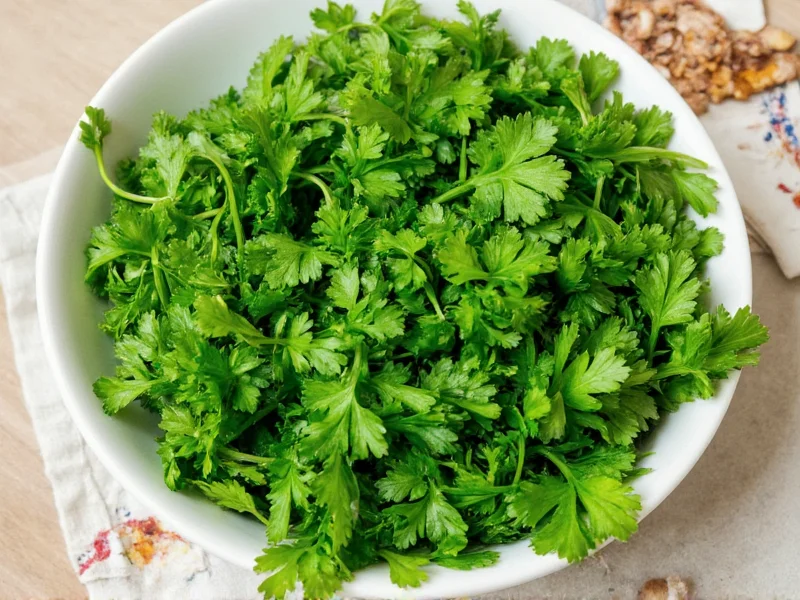Many home cooks and even experienced chefs frequently confuse cilantro and parsley due to their similar leaf structures and shared presence in herb gardens. This confusion can lead to disappointing culinary results when a recipe calls for one but the other is substituted unknowingly. Let's explore the key distinctions that set these two popular herbs apart.
Botanical Background: Understanding the Fundamental Differences
Cilantro, also known as Chinese parsley or coriander leaf, comes from the Coriandrum sativum plant. Interestingly, the seeds of this same plant are what we call coriander—a common point of confusion. True parsley belongs to the Petroselinum crispum species and has no such dual identity. While both herbs share the same plant family (Apiaceae), they are genetically distinct species with different chemical compositions that create their unique flavors.
Visual Identification: How to Tell Cilantro and Parsley Apart
The most reliable way to distinguish between these herbs is through careful visual inspection. Though they may appear similar at first glance, several key characteristics set them apart:
| Feature | Cilantro | Parsley |
|---|---|---|
| Leaf Shape | Rounded, almost circular edges with a slightly scalloped appearance | Pointed, serrated edges resembling curly lace (curly parsley) or flat, pointed tips (Italian parsley) |
| Leaf Texture | Softer, more delicate texture that wilts easily | Firmer, more robust texture that holds shape better |
| Stem Color | Pale green to light purple | Bright green |
| Overall Appearance | Leaves appear more rounded and uniform | Leaves have more defined points and jagged edges |
Flavor Profiles: Why Substituting Matters
The flavor difference between cilantro and parsley is perhaps the most significant distinction for culinary purposes. Cilantro delivers a strong, citrusy flavor with notes of lemon and sage, which some people genetically perceive as soapy due to a variation in olfactory-receptor genes. This polarizing characteristic means cilantro can make or break a dish for certain individuals.
Parsley, by contrast, offers a much milder, slightly peppery and grassy flavor that serves as a versatile background note in many dishes. Italian (flat-leaf) parsley has a more robust flavor than curly parsley, but neither approaches the intensity of cilantro. When exploring whether you can substitute parsley for cilantro, the answer depends on the recipe—some dishes can accommodate the swap with minor flavor adjustments, while others would be fundamentally altered.
Culinary Applications: When to Use Each Herb
Cilantro shines in dishes where its bold flavor can complement other strong ingredients:
- Mexican cuisine (salsas, guacamole, tacos)
- Asian dishes (curries, pho, Thai salads)
- Middle Eastern recipes (chutneys, raitas)
- Fresh garnishes for soups and stews
Parsley's milder profile makes it more versatile across cuisines:
- Mediterranean dishes (tabbouleh, gremolata)
- As a garnish for virtually any savory dish
- In bouquet garni for soups and stocks
- As a key ingredient in chimichurri and persillade
Nutritional Comparison
Both herbs offer impressive nutritional benefits, though with some differences. Cilantro contains higher levels of vitamin K and certain antioxidants, while parsley is particularly rich in vitamins A and C. A nutritional comparison of cilantro and parsley reveals that parsley generally has slightly higher concentrations of most vitamins and minerals, but both contribute valuable nutrients to dishes in small quantities.
Growing Characteristics
If you're growing your own herbs, understanding how to tell the difference between cilantro and parsley while they're still in the garden is helpful. Cilantro grows quickly but bolts (goes to seed) faster in warm weather, while parsley establishes more slowly but has a longer productive season. Cilantro flowers are white and lacy, eventually producing coriander seeds, while parsley produces yellow-green flowers.
Common Misconceptions
One widespread misconception is that cilantro and coriander are different plants—actually, they come from the same plant (Coriandrum sativum), with cilantro referring to the leaves and coriander to the seeds. Another common error is believing that young parsley looks identical to mature cilantro—while they share some visual similarities, the leaf shape differences remain consistent throughout growth stages.
Substitution Guidance
When you find yourself asking 'can I substitute parsley for cilantro' in a recipe, consider these factors:
- For Mexican or Thai dishes: Avoid substitution as cilantro's unique flavor is integral to authenticity
- For garnishing: Parsley can often replace cilantro with minimal impact
- For sauces and dressings: Adjust other ingredients to compensate for flavor differences
- If substituting: Use 1.5x the amount of parsley to approximate cilantro's presence
Remember that dried versions don't make suitable substitutes for either fresh herb, as the drying process significantly alters their flavor compounds.
Final Thoughts on Cilantro vs Parsley
Understanding the difference between cilantro and parsley goes beyond mere identification—it's about respecting each herb's unique culinary role. While they may share visual similarities that cause confusion, their distinct flavor profiles make them irreplaceable in specific culinary contexts. By learning how to tell the difference between cilantro and parsley, you'll elevate your cooking precision and avoid the disappointment of unexpected flavor outcomes.











 浙公网安备
33010002000092号
浙公网安备
33010002000092号 浙B2-20120091-4
浙B2-20120091-4